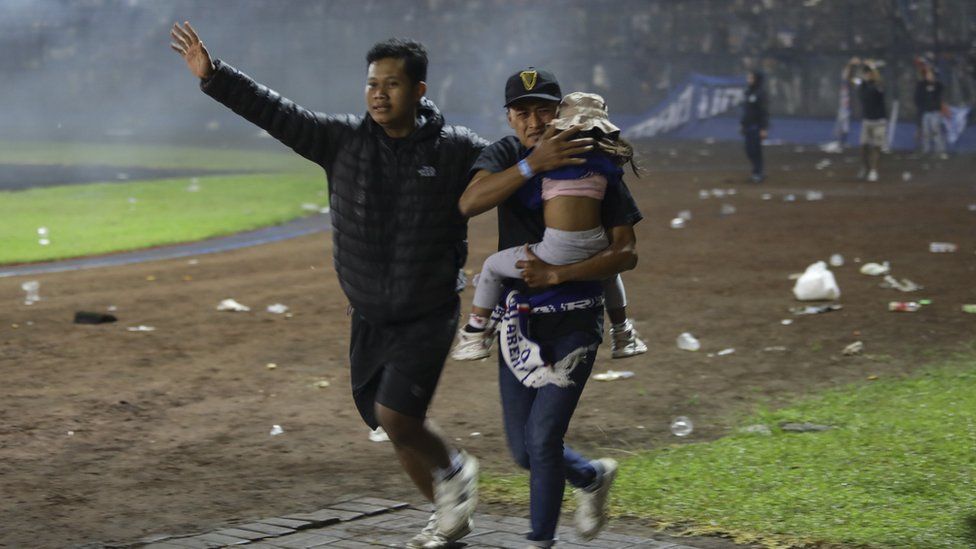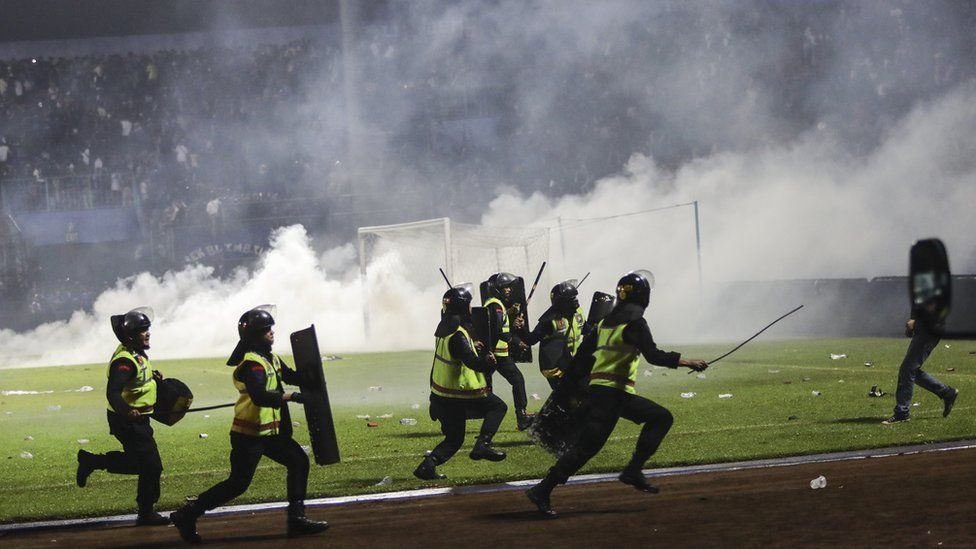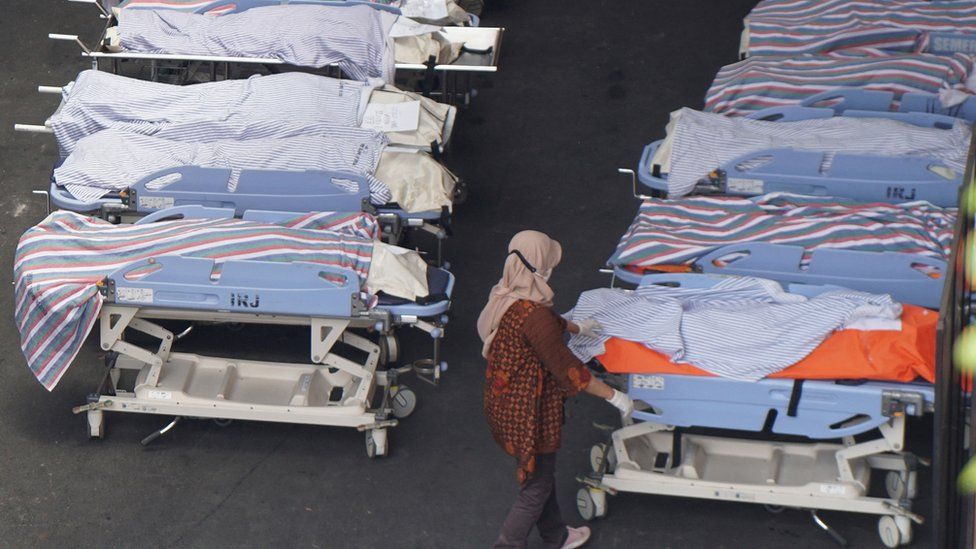
Indonesians are demanding answers after a football match between two rival clubs turned into one of the worst disasters in the sport’s history.
On Saturday night, thousands of fans rushed onto the pitch after their home team lost a game at Kanjuruhan stadium in Malang, East Java. Police responded by firing tear gas.
In the panic to escape, people were trampled and crushed at the exits. At least 125 – including dozens of children, one as young as three – were killed, the authorities say.
Some fans died in the arms of the players they had come to cheer on just hours earlier, the coach of home team Arema FC revealed.
“I can only mention a terrifying scenario,” Sergio Silva, a Portuguese star for the side said. “Police cars on fire, everything broken, corridors with blood, people’s shoes.
“People were desperate, they had seen people die and were trying to escape,” he told Portugese sports newspaper, A Bola.
Authorities on Monday launched an investigation – following allegations of heavy-handed policing. Public anger has escalated – with mourners chanting “murderers” at officials. At least 18 police officers are being investigated for their action on field.
So how did this all unfold? Here’s what we know so far.
A fraught history
There had been concerns in the lead-up to the game – between Arema FC and long-time rivals, Persebaya Surabaya, another East Java-based team – as violence between fans was not unprecedented.
So extra precautions were put in place – including more security “for preventive measures”, Maike Ira Puspita, deputy secretary-general of the Indonesian Football Association, told the BBC.
They also banned visiting Persebaya fans from coming to the match, meaning it was just a home crowd – an over-capacity attendance of 42,000 people – who roared on their team on Saturday night.
The FA also deployed extra police. And during the game’s first half, all was “manageable”. “The security happening like usual,” says Ms Puspita. “Half-time was ok.”
But when the game ended, Arema had lost 3-2.

“And this is the point when some of the supporters ran onto the pitch. And it all just started to break out from there,” Ms Puspita said.
It is unclear – and in fierce contention – what exactly happened next. Authorities are unwilling to even specify a chronology of what happened on the field.
“I think it’s better for all of us to wait for the investigation team,” Ms Puspita told the BBC.
But what is known is that after the final whistle blew, Arema fans moved onto the pitch, where the team’s footballers were gathered in the middle.
Sergio Silva said many of those streaming onto the field had appeared to come to “show support, not attack”. But recognising the situation was escalating, the team returned to the changing rooms.
At some point, police began to fire tear gas into the thousands-strong crowd, volleys aimed at dispersing them. One eyewitness told the BBC that police fired tear gas rounds “continuously and fast”.
Witnesses say police were unnecessarily brutal – and that along with the clouds of stinging gas, officers were beating fans with batons.

The gas had an overwhelming effect – sparking a mass exodus. Fans fled down the field, heading towards the stadium’s narrow exits. But with a crowd of thousands beating at each others’ backs, and with many still suffering gas inhalation, it became a crush at the gates.
In the scrabble to get out, people punched and clawed holes in the wall to try and pull themselves free. The weight of people pushing against the iron gates left them bent outwards. In other places, the crush left some people dying by the changing rooms.
Huddled in the locker rooms, Silva said he and his teammates spent what felt like hours barricading themselves. They heard the roar of the crowd, the screams of distress in the corridors.
“People were desperate, they had seen people die and were trying to escape. We ended up letting in some of these people,” he said.
It was, he said, a scenario more reminiscent “of destruction, of war… nothing to do with football”.

“Fans died in the arms of players,” Javier Roca, the Arema coach, told Spanish broadcaster Cadena Ser. “I’m mentally shattered. I feel a heavy burden, even a heavy responsibility.”
He added: “I think the police overstepped their mark.”
The exact death toll is yet to be confirmed. Many fans are undergoing treatment, and some of those injured are reported have suffered brain injuries.
Police under scrutiny
Police have characterised what happened as a riot in which two officers also died. They’ve accused fans of attacking officers and damaging cars – the burnt-out wreckage of vehicles can be seen in photographs.
But anger against officials is rising: at vigils across the nation, protests have broken out calling for police to be held accountable. In the capital Jakarta, mourners chanted “Murderer! Murderer!” and taped signs reading “Kanjuruhan Massacre” to fences.
In Malang, anti-police messages have been graffitied on the Kanjuruhan stadium.
On Monday, Mohammad Mahfud Mahmodin, Indonesia’s minister for political, legal and security affairs, said the government was asking police to “reveal the perpetrators involved in the crime”.
He said a soldier had been seen in footage carrying out an unauthorised act, without specifying what it was.
Separately, the police have announced an investigation into 18 officers who were “holding the throwing weapons”.

Indonesia is known for violent flare-ups between rival football supporters. The country’s police force also has a record of brutality – and has been criticised for frequently using tear gas, despite it being banned by Fifa, world football’s governing body, as a crowd control measure.
“In many riots in football stadiums, police are accustomed to using tear gas – this is an abnormality that has been normalised,” said Fajar Junaedi, a lecturer and football researcher at the Universitas Muhammadiyah Yogyakarta.
He noted a case in 2012, where a supporter died from being tear-gassed by police and there was no follow-up investigation.
Ms Puspita had earlier declined to answer the BBC’s question on whether the police use of tear gas was a standard accepted procedure in the Liga.
She stressed the actions organisers had taken earlier in the year to help teams manage crowds, including security workshops for first league clubs and coordination with police.
“At this point, it is unfair to point fingers. This is something that’s a black day for all of us – a tragic and devastating incident,” she said.


